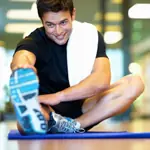
As football players, ballerinas, and high-mileage runners can tell you, you're as old as your knees. The same goes for active women. For me, it wasn't the usual suspects, basketball or downhill skiing, that added unwanted years. Those little aches and pops, I learned, were due to too much rigorous walking without enough rest.
With knees you need to be careful not to overuse or abuse, says Etty Griffin, M.D., staff orthopedist at Peachtree Orthopedic Clinic in Atlanta. Whether it's more hills or faster walking than you're used to, doing too much too fast can be stressful for tissue around the knee.
Any exercise with rigorous knee bending (remember Tae-Bo?) is a possible culprit, says Griffin. Any unfamiliar activity taken on very quickly can lead to problems. Tissue needs time to heal, or microtears from overuse can cause pain.
A lopsided workout plan can also be hard on the knees. When fitness walking, some muscles are overused, while others are not used at all, says John Jay Wooldridge, Reebok master trainer. The imbalance can stress the related joints.
But don't get the idea that knee problems are inevitable. Cross-training, stretching, and strengthening can all help knees stay pain-free. While knee pain should always be checked with a doctor to rule out injury, early arthritis, or other serious conditions, the good news is that knee pain from overuse is usually solvable with ice, rest, and controlled exercises that promote healing, says Griffin.
These six exercises target often-neglected areas that support the knee, such as hamstrings, quadriceps, lower back, and gluteal muscles. For women in particular, quadriceps muscles may be overdeveloped on the outside compared with the inside, which can pull the kneecap off balance. To build a more balanced body, Wooldridge recommends doing this routine two to three times a week, ideally following a walk, when muscles are warmed up. Do the stretches last, as part of a cool-down.
1. Straight Leg Lift
Targets: Quadriceps and hip flexors. Complements the walking motion by working muscles in opposition that may be underused, such as the smaller quadriceps muscles of the thigh.
Cues: Begin lying on back with right leg straight and extended; left knee is bent, with left foot flat on floor. Contract right thigh muscles to straighten (but not lock) the knee. Slowly raise leg until knees are parallel, then lower. Repeat 8 to 12 times, working up to 2 sets on each side.
To advance: Begin holding to a 35 count in the up position.
2. Wall Sit
Targets: This multi-dimensional exercise targets the hamstrings, quadriceps, gluteal muscles, and abdominal muscles. A lower-intensity alternative to squats and lunges.
Cues: Stand with lower back against an exercise ball of about 25 inches that rests against a wall. Feet are shoulder-width apart and a comfortable distance from the wall. Body is erect. Slowly bend knees and lower body until thighs are parallel with the floor; keep knees above (not in front of) feet, and abs contracted to avoid excess sway in the back. Pause at the bottom, then roll back up. Repeat 8 to 12 times, working up to two sets. to advance: Increase pause at the bottom to three, five, or even 10 counts.
3. Bridge
Targets: Glutes, hamstrings, and trunk, including lower back and abdominal muscles.
Cues: Lie flat on back, with arms by sides, palms up. Both knees are bent, feet flat on the floor. Using abdominal and gluteal muscles, slowly lift trunk and hips off floor with a smooth, controlled motion. Squeeze buttocks at the top, then slowly lower. Keep pressure on the shoulders, not on the head, and do not push with the hands.
If you feel cramping in the hamstrings, you'll know they're working too hard; lower slightly to relieve that tightening. Repeat 8 to 12 times, working up to two sets. to advance: Hold the up position for a 35 count.
4. Single Calf Raise
Targets: Ankle stability is critical to proper knee alignment. This move builds calf strength and ankle stability, as well as body coordination and balance.
Cues: Hold onto a chair or support yourself against a wall, and lift right leg into a hamstring curl (shin parallel to the ground); extend left ankle and lift body on the toes. Slowly lower and repeat 8 to 12 times.
Finishing stretch: Step forward with right leg, keeping left leg straight and left heel on the ground, for a gentle calf stretch. Hold for 6 to 8 slow, deep breaths; then repeat exercise and stretch on the other side. Do two sets on each side.
To advance: Add a third set, placing hands on hips for balance.
5. Quadriceps Stretch
Targets: Quadriceps, hip flexors.
Cues: Lying on side, with hips and shoulders stacked, pull the top foot toward the buttocks with the top hand. If you have trouble, use a towel or T-shirt to extend grip; foot does not have to reach buttocks; pull to the point of feeling a gentle stretch, not pain. Keep knees in alignment, then slowly pull top knee back behind the other knee, while maintaining stacked hip. Hold for 6 to 8 slow, deep breaths. Repeat 2 to 3 times on each side.
6. Modified Hurdlers Stretch
Targets: Hamstrings, gluteal muscles, lower back.
Cues: While seated, extend one leg straight (do not lock knee) and place bottom of the other foot against that knee. Holding shoulders and hips square and back straight, slowly lower torso toward straight leg. Do not collapse through chest or round the back. Gentle pressure on the bent leg will stretch the inner thigh. Hold for 6 to 8 slow, deep breaths; repeat 2 to 3 times on each side.
To keep your knees healthy, follow these tips from our trainer.Dos for Healthy Knees:
- Always see a doctor if you experience knee pain that is not relieved by several days of rest, ice, massage, and elevation.
- Back off from activities such as walking hills or knee-bending exercises that cause you pain.
- Build adequate muscle strength, especially in the quads, hamstrings, glutes, and ankles.
- Stretch adequately, emphasizing quad and hamstring muscles. Warm up before stretching.
- When doing squats, lunges, or leg presses, avoid locking knees completely. Use low weight and high repetitions.
- Maintain a healthy weight.
- Wear shoes appropriate for an activity. Seek proper arch support if your feet roll in.
- Cross-train. Do 2 to 3 activities on a regular basis to balance out the body.
Don'ts for Healthy Knees:
- Don't ignore or exercise through pain.
- Never overdo unfamiliar activities.
- While walking, Don't exaggerate your stride, overarch the back, or lock knees as you extend.
- On an elliptical trainer, exercise bike, or stair climber, never straighten legs completely.
- Don't overextend knees, especially while pregnant, when hormonal changes allow for greater fluidity of movement.
- Don't give up on exercise completely because of pain without checking with your doctor about alternatives.
- Don't forget that overall stability, torso strength, and proper posture are key.





Discuss This Article